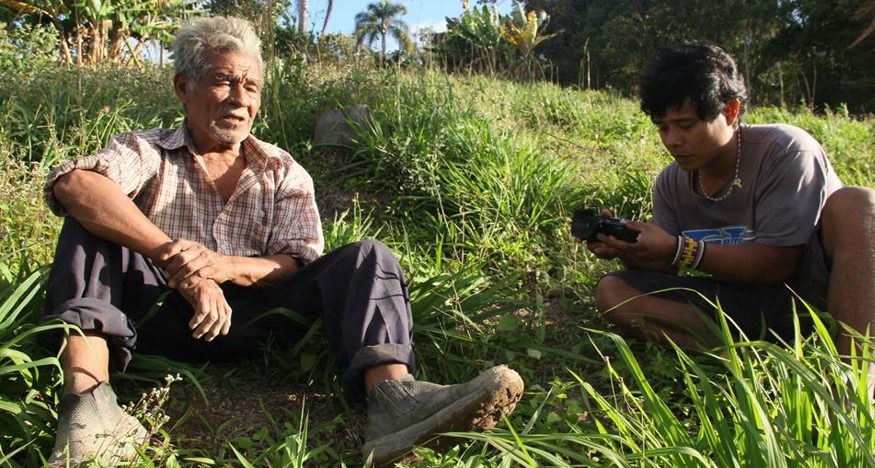From the Village to the Cinema: Where the Image Meets the Story
Belo Horizonte, 2018

When you film your own people, it’s easier to direct the shoots, you know where to start from. When it’s other people, you’re kind of lost, you don’t know how much you can show. Each people have a system, a rule for coexistence and a different way of seeing the world where they live. Because filming is like singing. For example, to learn how to sing in Guarani, you must learn to hear the sound and rhythm of the song. It’s the same thing with the camera, you must learn to hold on to knowledge and use the equipment as if it were your second eye, listening to and respecting each interviewer’s moment; this is how I learn with the elders in the village all the time.
When I went to the village with the camera to film for the first time, I did not know what I was going to shoot or how, therefore the Xeramoin[1] saw all of this in me. Despite him being my main protagonist, I had the pleasure of being taught how to shoot and frame shots by Xeramoin Alcindo. The Xeramoin became my film teacher, showing me how I could film him and which side I should position myself on with the camera to film better. I captured different shots for the film, without having the least idea of which shot I was using to frame the images. I learnt to film by practising, by using the camera while I was in the village. Where Xeramoin Alcindo went, the camera and I followed him as he went about his business in the village.

The most interesting thing is that the Xeramoin found many things to do, and it seemed as if he purely did this to teach me how to film. When we were walking together, he felt comfortable recounting his life stories, and displaying his wisdom. In 2012, I filmed his 104th birthday, and I was more aware of the responsibility I had, to record a little of that immense wisdom.
On one of our walks to the small-holding, I was filming against the light and the Xeramoin told me that if I kept shooting like that, the sun’s light in the lens would burn the camera. On that day, I thought in more depth about the place of the image, and the framing that I should use. I realised that I should be more careful regarding the matter of the light. This was how I started to understand that my dream of making a film was becoming a reality.
I was very happy, and honoured, to pay homage to Xeramoin Alcindo in my first film. It was he who taught me to walk with the camera. Each image that I captured with the Xeramoin was special for me, every framing that he taught me to shoot. The Xeramoin always joked with me by saying: don’t be scared of this equipment, pretend that this is a toy camera, and you’re learning to catch an “empty wind” inside it.
After Xeramoin Alcindo’s teaching, I started to use the camera as if it were a petyngua[2], so that I could spiritually connect myself with the wisdom of the silence. I started to use my imagination in the world of the lens, without being scared of breaking the equipment. The equipment comes at a price, we can mend it. Memory has a greater –incalculable – value. It is priceless. And when it is lost, it’s difficult to bring it back.
Translated by Katy Carroll